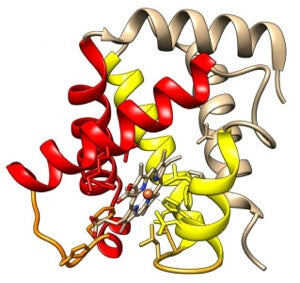Researchers recently made an important discovery in protein science that will advance our understanding of the inner workings of cells. In an article published in Scientific Reports, the team said they found a critical evolutionary link between a protein’s structure and its function.
Like tiny molecular machines, proteins handle a variety of functions from transporting chemicals to breaking food down into nutrients. The vast range of protein function is possible because of their unique gene-encoded sequence of amino acids, which affects the three-dimensional shape that folded protein chains adopt.
To better understand them, researchers have sequenced and resolved a huge number of protein structures. Currently, the Protein Data Bank includes 110,000+ structures—far more than the number with known functions. Powerful bioinformatics tools assist in making correlations between the shape and purpose of a protein, but what’s been missing is a direct structure-function link, tantamount to a Rosetta stone-like key.
Fortunately, such a key has now been unearthed.

Researchers in the lab of Professor Gustavo Caetano-Anollés at the University of Illinois examined specific sequences that code for small “loops” in proteins. These loops are critical components in forming active sites, which are the pockets within the protein where functions often take place.
“It turns out that there are little snippets in our genes that are incredibly conserved over time,” Caetano-Anollés said. “When we look at higher organisms, such as plants, fungi and animals, as well as bacteria, archaea, and viruses, the same snippets are always there. We see them over and over again.”
By investigating networks to probe the linkage between a protein’s unique structure and its molecular function, the researchers discovered that loops have been utilized in active site formation throughout the geological record. These loops are the first step in being able to understand the function of proteins in cells from billions of years ago to today.
“The big problem in biology is the question of how a protein does what it does. We think the answer rests in protein evolution,” Caetano-Anollés said. “For the first time, we have traced evolution onto a biological network.”
It appears the loops are conserved through an emergent property referred to as hierarchical modularity, which is “the building of small cohesive parts into larger and increasingly complex wholes,” according to Caetano-Anollés.
Hierarchical modularity occurs because in large networks complex organizations of components arise. These organization are referred to as cohesive modules, and they’ve been observed in nonbiological systems as well, including manmade networks like the internet.
Now that the researchers’ methods have identified loops as cohesive modules, the approach can be used to search for other patterns retained across the timeline of protein evolution.
While this research clearly has value to unraveling protein structure-function relationships in ancient and modern organisms, that loops are so key to active site formation will be of particular interest to synthetic biologists interested in the design of new proteins.
In fact, the more cohesive modules identified, the easier it will be to create entirely new sets of proteins with desired functionalities, opening the door to true designer proteins.
Banner image credit: Shutterstock.com



